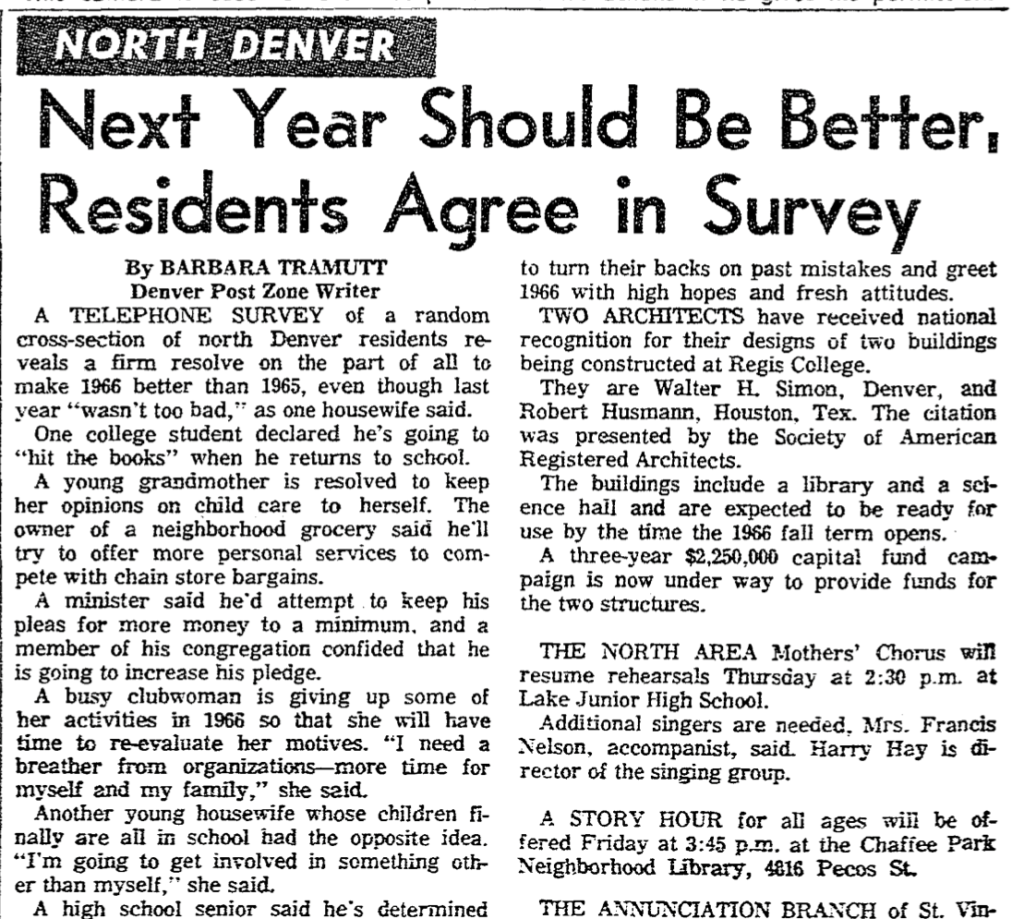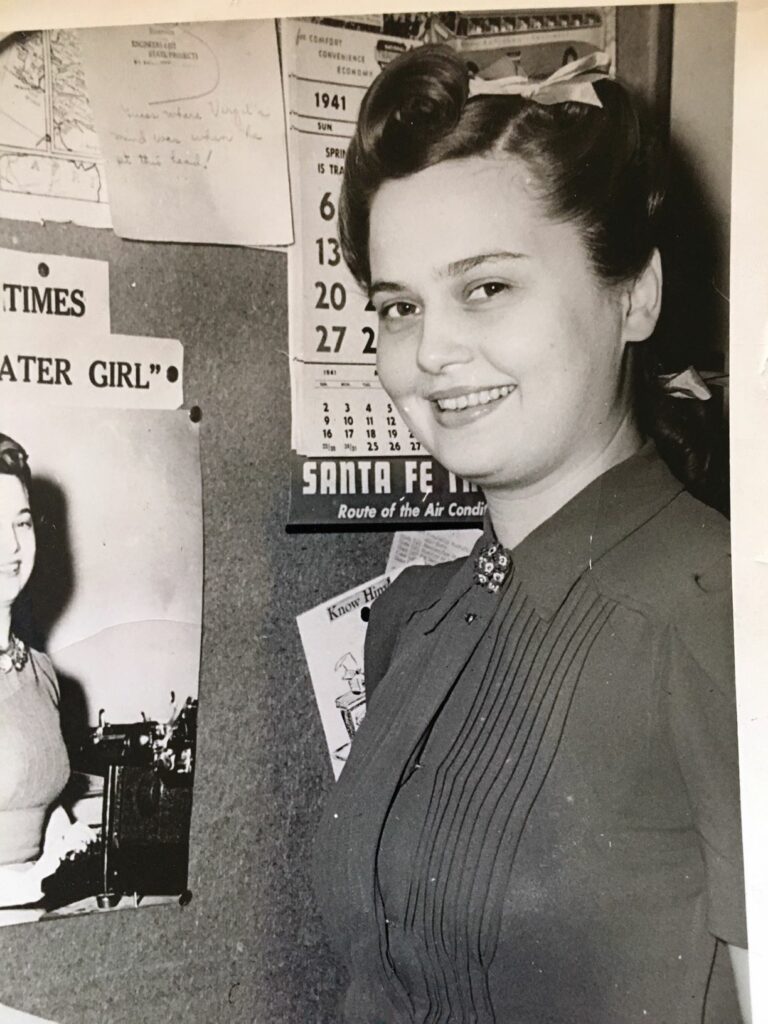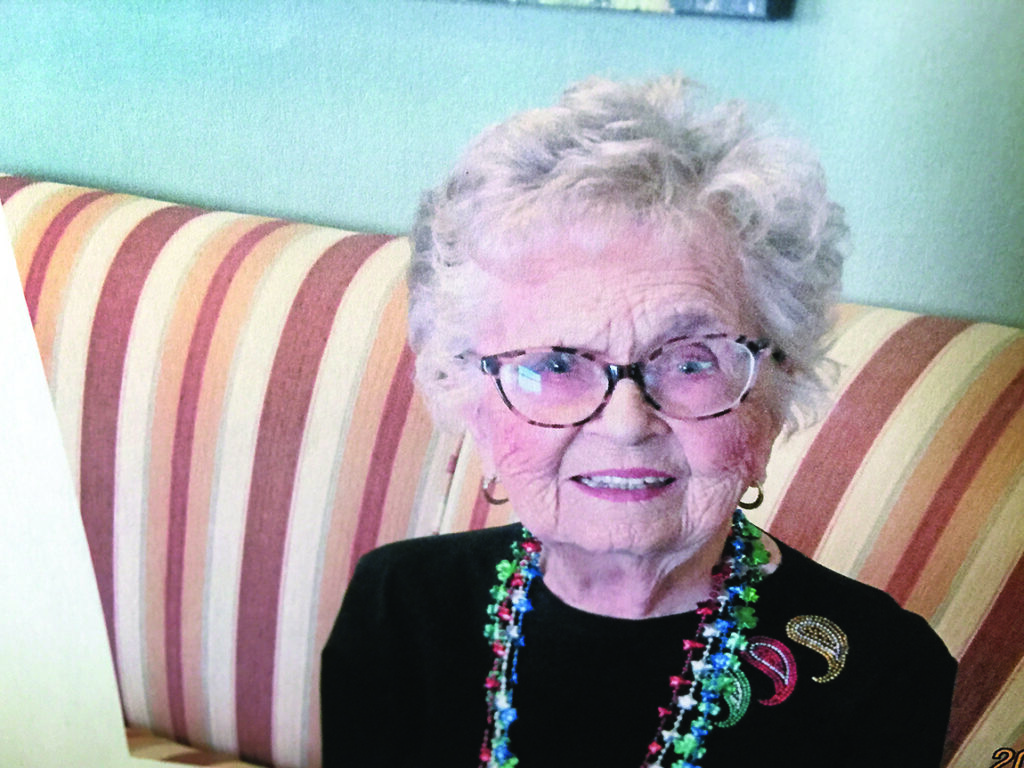The tap-tap-dunt-tap-tap-thunk-DING-zzzzzzzzz of his mom’s typewriter reached Larry Tramutola’s ears from the basement of the red brick house on West 34th Avenue near Zenobia Street.
It was 1965. Paul and Barbara Tramutt’s children were in college or at the tail end of school years at Edison, Skinner, and North. Their childhoods were spent entirely in North Denver: the theatre on 44th and Tennyson, the barbershop around the corner, Elitch Gardens a block away, Smiley Library, Carbone’s on 38th. “We occasionally left the neighborhood to visit our uncle or to go to the YMCA,” recalls Tramutola, the youngest of the three, “but to us, North Denver was our world.” Over time mom encouraged them to go further—to get involved—and so off they went.
And as they did, Barbara Tramutt reprised a journalism career she had left behind in Okmulgee, Oklahoma when she married in 1944. It was a career she paused during her first two decades in Denver, before picking it back up again to write for the city’s longest running daily newspaper. She brought an important voice and a sense—gained during WWII–of a community discovering itself to the changing North Denver that had become her home.

Zone 3
In August 1965 Tramutt began filing stories—several a week—for The Denver Post. She covered Zone 3, a large expanse of the metro area from North Denver to Lakewood to Golden. The paper printed Zone 3 news on Wednesdays, with Tramutt taking charge from August 1965 to June 1981.
Those years took Denver from a flood breaching the banks of the South Platte River to decades of change across North Denver schools and businesses, and countless development projects proposed and battled about.
Tramutt set down to The Denver Post job just two months after the devastating flood of 1965, an event Alan Prendergast chronicled in 2015 through “The 1965 Flood: How Denver’s Greatest Disaster Changed the City.” It was a weather event of rain, hail, and tornadoes that picked up steam over several days across Colorado culminating in 250,000 acres inundated. 21 people died, more than 1,700 buildings were destroyed or damaged, and countless livestock and all manner of debris swept into the river. Low lying areas adjacent to Denver’s stretch of the South Platte took the greatest hit.
North Denver felt the crisis of residents displaced and homes lost, to ripple effects lasting decades. According to Tramutt’s successor Beth Sagstetter, the flood “changed everybody and everything.” By the time Tramutt’s January 5, 1966 dispatch rolled off the presses, it was no surprise the headline read, “Next Year Should Be Better, Residents Agree in Survey.”
A stretch of the new Interstate Highway System began its creep through North Denver. The segment of I-70 continuing west from I-25 toward the mountains had finally been funded and an agreement with Utah inked. By December 1965, road construction between I-25 and Federal Boulevard was complete. In 1966 one could drive all the way to Sheridan. On November 17, 1965, Tramutt turned her attention to the highway’s impact on a neighborhood school. The Remington School PTA had launched a petition protesting the hazards road construction had created for students coming and going from school at West 46th Avenue and Pecos Street.
Long before Next Door, The Denver North Star, and daily local podcasts, Zone 3 covered fundraising events and public talks. It announced awards, championships, homecomings. Tramutt’s stories unfolded over the decades—in parallel with The North Denver Tribune and alongside something called phone trees—getting the word out and tucking neighborhood news into regional and national storylines.
By the time Tramutt wrapped up her Zone 3 coverage for The Denver Post in 1981 she seemed drawn to loose ends. On June 3, 1981, she filed a story updating neighbors on a plot of Denver adjacent to North High School. “North Denver residents are asking what has become of plans for the park euphemistically referred to as ‘Gateway Park.’ For well over a year, they have watched the triangular land parcel on the east side of Federal Boulevard, between West 29th Avenue and Speer Boulevard, as homes and businesses were carted away or razed. So far, no park, and the area has become a rather tacky parking lot and pedestrian shortcut. A check with the city’s parks planning office reveals that the parcel has not been forgotten.”
Tramutt’s farewell column on June 24, 1981, reflected back to her first days in the world of “ink and newsprint,” going all the way back to the first chapter of her career in journalism during the 1930’s and 40’s. It began at age 15. She was Barbara Frevert back then and had just been invited to work on a special back-to-school edition of the Okmulgee Daily Times in Okmulgee, Oklahoma.

The All-Female Newsrooms of WWII
Tramutt began her journalism career in 1938 when she took a full-time job, after college, back at the Okmulgee Daily Times on the society desk. Years later she reflected, “As time went on, the roles changed from society editor to police reporter, to obituaries, to general assignment, to copy editor and then to managing editor for what the AP described as the state’s first “Powder Puff” (all female) staff. It was an honor that resulted not so much from efficiency as from expediency, as the men went off to the armed forces.”
Tramutt’s tenure at the Daily Times overlapped with a period, from 1940 and 1945, when the percentage of females in the U.S. workforce grew from 27% to nearly 37%.
During WWII, in her column the Night Watch, Tramutt coached Okmulgeans through many facets of adjustment to wartime. The town of 16,000 hosted MASH Unit training grounds, a glider school and a hospital for injured soldiers. It was a small southern town with a clear sense that it was playing its part. The front page carried stories from Washington D.C., London and Allied headquarters in Algiers. In the Night Watch, Tramutt promoted war bonds and cooperation with rationing efforts; she implored Okmulgeans to favor involvement over complacency; and, she revealed behind-the-scenes details of life in a wartime newsroom.
And she didn’t shy away from confronting backwards attitudes about women, including those she later admitted to harboring herself. On January 13, 1942 she took aim at the “well-meaning critic” who thought he was paying her a compliment when he said, “a certain Night Watch column was timely and well written; so good, in fact, that it was inconceivable that it was written by a society editor.”
She challenged the negative tone the term “working women” had taken, reminding readers that women were–capably and proudly–taking on work to benefit the entire country.
Occasionally injecting humor, Tramutt made an appeal to ban the workplace pantyhose requirement. “This Night Watch seems to be an ideal opportunity to dust the cobwebs out of the back pockets of our brain. Along the subject of reform, I wonder why feminine office workers can’t demand their rights when it comes to the subject of appropriate leg attire while on duty?” If employers couldn’t spare the “sandpaper and elbow grease” to smooth the edges of office furniture, why not just “go bare-legged or wear ankle socks?”
In January 1943, Tramutt foretold of the departure from the workforce she and other women were prepared to make when the war ended. She recounted droves of soldiers who struggled to regain employment upon return from WWI, and she calmed Okmulgeans’ fears that this latest generation of women would not remember that.
On January 8, 1944, Tramutt said goodbye to Daily Times readers. She also allowed herself one last opportunity “to let off some accumulated steam about ‘working women,’ as we are called by those who are jealous or disgusted. Frankly, I’m not sorry for leaving for I have just about the best reason for doing so. There are one or two lessons I’ve learned, however, which are yours. Take them for what they’re worth. The main one is this: I have learned to work with women and appreciate them and never again will I be guilty of complaining that my own sex is narrow, stupid, or dull.”
A year later in 1945, WWII ended and her husband, Army Captain Paul Tramutt, was released from training Army MASH units. They moved with their first child to North Denver, where Paul Tramutt had been raised and where his parents settled after immigrating from Potenza, Italy.
Never Lost Sense of Who She Was
The Tramutt family grew to five by 1948. Barbara Tramutt found her place in a city twenty times the size of Okmulgee. She cherished the Italian community of her in-laws. “Mom adjusted to the times and to the culture without ever losing a sense of who she was,” Tramutola recounted, “She’s a strong woman, in a traditional sense. Our father was a tough Italian man,” he paused, and his voice lightened, “She could stand up to him.”
During years when formal ties to journalism were set aside, Tramutt brought her editorial expertise to the kitchen table. She taught her children that writing takes time. “Good writing is good editing,” Tramutola says. “It’s as much about eliminating words as it is about adding them. You have to struggle with it,” and then, “She had a passion for writing. She had a gift.”
By the time Tramutt picked journalism back up in 1965, she had become the North Denver of the day. She loved her adopted community: the people, the stories, the ins and outs of grappling with change.
And after 1981?

In 1984, grass and trees were finally planted on that triangular plot of Denver now Viking Park. Benches were eventually installed, though not without controversy.
Tramutt traveled, dug further into music she loved, and continued to make friends easily. At the assisted living facility where she’s been riding out the pandemic, she’s referred to as the “life of the place.” Her three children have led to 8 grandchildren and 12 great grandchildren, who are frequent visitors.
Perennial lessons from early years in journalism might resonate with Tramutt today. On January 7, 1942, her Night Watch commented on lives put on hold during WWII. “We don’t mean to be morbid about the situation. What’s happening to us has happened before, and the human race is still going strong. Our worries aren’t new ones by a long shot—but that doesn’t make them any easier to swallow. What we need now is assurance that this isn’t in vain. Putting our personal goals off a year or two more won’t make much difference—IF we know we’ll be given a whack at living our own lives when the time finally comes.”
Barbara Tramutt’s life now spans 101 years, expressing wisdom gained from The Great Depression and WWII on through to the global COVID-19 pandemic. Her life is–in important ways–a story of American women over a century.
And it is also the timeless story of who we are as human beings: continually adapting to our times and our surroundings, forming relationships that in turn shape us, challenging people to “dust the cobwebs out of the back pockets of our brain,” and finding our place amidst events that bear down on us.
Kathryn has lived in North Denver since around the time the Mount Carmel High School building was razed and its lot at 3600 Zuni became Anna Marie Sandoval Elementary. She’s raised two children in the neighborhood, worked at several nonprofits, and facilitates a Caregiver Support Group for the Alzheimer’s Association Colorado Chapter.
Do you have story ideas for The Gray Zone? Email Kathryn@DenverNorthStar.com

Thank you so much for your article on mom. We all loved it, as did her extended family and friends. I also loved your recent article on Adeline Cic. I knew/know her children, all of her family history – places, routines, etc are familiar to those of us who grew up in North Denver. You do a great job and your stories really are a refreshing look back.
Thanks for you hard work,
Susan Tramutt Nunnery
Susan, we appreciate you reading and for taking a few minutes to comment!
Kathryn
Great story! So glad to see she is still with us.
Hi Mary Lou – I’m glad you liked the story. Tramutt’s life has covered a lot of ground (so far!), a slice of which we were able to cover here. Thank you for reading!